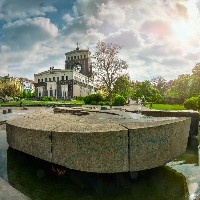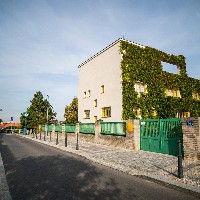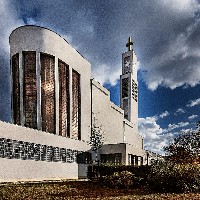Breadcrumbs navigation
The First Republic – Czechoslovakia's Golden Era
The First Republic (1918-1938) period is rightly remembered as our country’s golden era. During the first twenty years, newly formed Czechoslovakia managed to establish itself as a progressive, democratic, internationally recognized European state. Among other things, economic prosperity and public enthusiasm brought a great flourishing of culture, art, design and architecture.
Many of the admirable and remarkable works and buildings that attract art and architecture buffs from all over the world date back to the time between the two world wars. Let us revisit bygone times a century ago and remind ourselves of the best works created in Prague during those years.
Prague Castle, a Royal Residence turned Presidential
Nowadays, a visit to Prague Castle is a must for Prague visitors and residents alike. This is largely thanks to the first Czechoslovak President, Tomáš Garrigue Masaryk, who turned the originally regal seat into the offices of state for democratic presidents and one of the prime symbols of an independent republic. Fittingly, his statue stands on Hradčany Square directly looking toward the windows of the presidential office. It was placed here in 2000 by the last Czechoslovak and first Czech President, Václav Havel.
The decision to make the Castle the presidential seat of the new country led to a need for a major but sensitive remodelling and modernization of this heritage site. Masaryk entrusted the task to one of the best architects of his time, the Slovenian-born Jože Plečnik. The reconstruction began in 1920 and fundamentally altered the castle complex without adverse impact on the valued historical buildings. The additions and changes included new paving, flag masts, a granite obelisk next to St Vitus Cathedral but also the monumental Bull Staircase connecting the third courtyard with the Prague Castle South Gardens. These were the major changes to the Castle's visage. Terraced gardens were laid down on the site of the original medieval fortification (hence the name Na Valech, which means 'on the ramparts') the removal of which opened up a magnificent vista of Prague. This was intended by the architect to be a private refuge for the President's working and resting hours, but Masaryk soon opened it to the public.
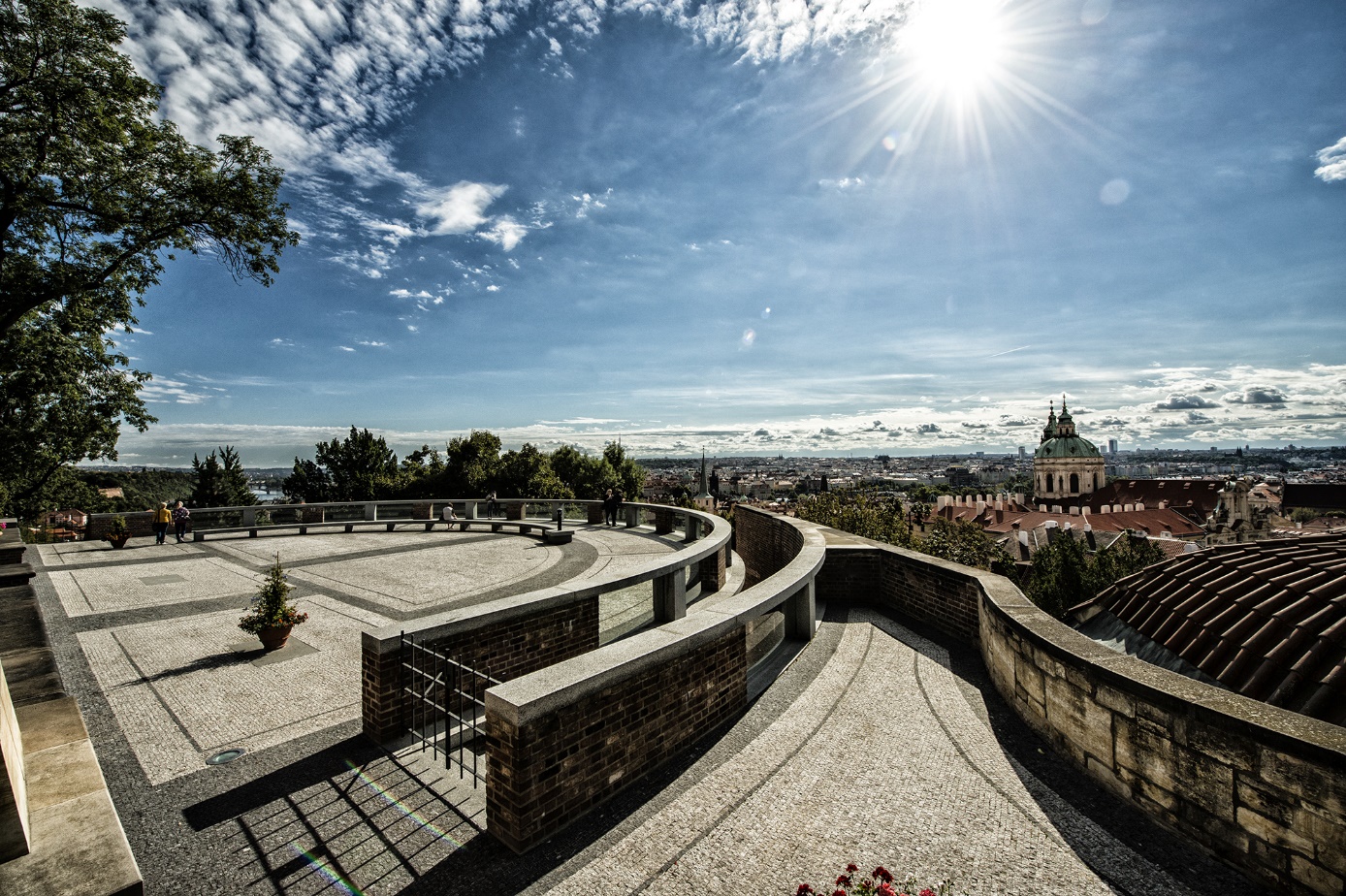
Lucerna Palace, Prague's first shopping arcade
Lucerna Palace was built in 1921 and is a great example of the transition between late Art Nouveau and early Modern styles. This iconic building, which served as a hub for Prague society, was the brainchild of ing. Vácslav Havel, the grandfather of president Václav Havel; he did not live to see it completed. There is a commemorative bust of him at the top of the staircase leading to the famous Lucerna Café and Cinema.
This distinctive building was a challenging construction project, the first in Prague to rely on reinforced concrete. The palazzo spaces served in various parts as offices, studios and apartments with terraces, but also included a cinema, ballrooms, restaurants and bars. Lucerna was also the first house in Prague with a shopping arcade passage, which connected Vodičkova and Štěpánská streets. It was later extended to join up with passages connecting the neighbouring palazzos U Nováků and the Rokoko. The Lucerna Great Hall was in its time a technical marvel, thanks to the anchoring of its reinforced concrete structure on a concrete slab recessed some 14 meters underground.
Back in the day, Lucerna was the real social hub of Prague, a place where leading Czech and world artists performed, including Josephine Baker and Louis Armstrong. The Lucerna Cinema hosted the first screening of a 'talkie' film in Prague.
The palazzo has remained popular to this day. Its roof terrace has been opened to the public, and in the summer season serves as a social and cultural centre with fantastic views of the city. The popular Lucerna Music Bar is still one of the most frequented music clubs in the city and the Great Hall hosts numerous social events. Directly under the glass dome of the arcade you'll find one of Lucerna's greatest contemporary attractions, a statue by controversial artists David Černý, of an upside-down horse, bestride whose belly sits the Czech patron St Wenceslas.
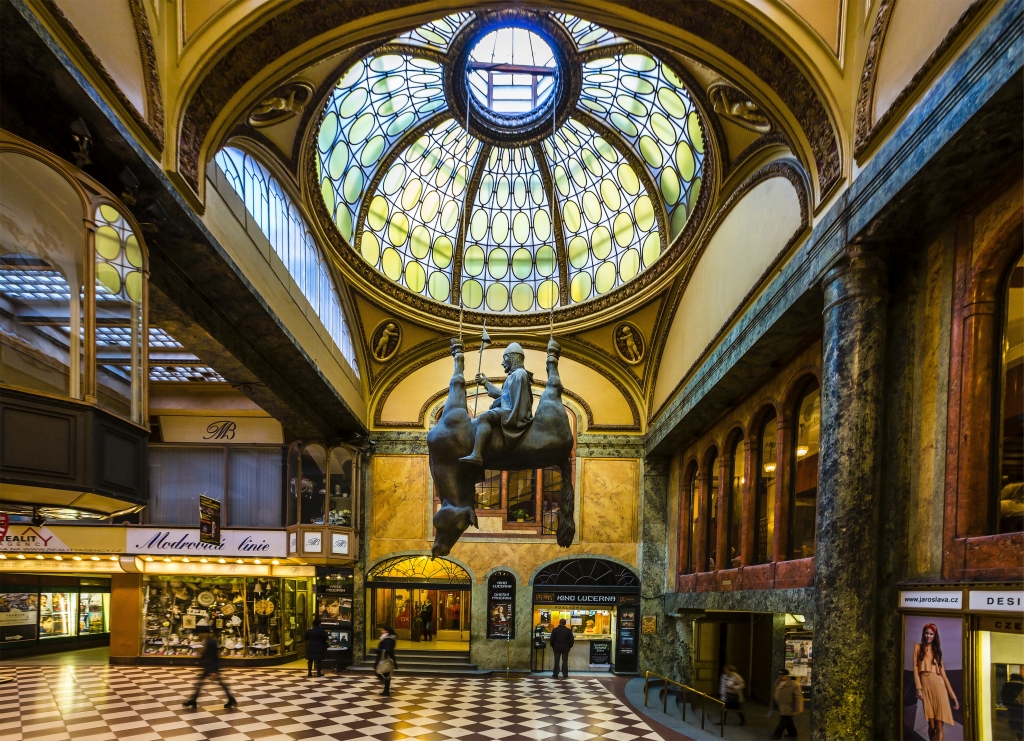
Rondocubism, the Czech national style
The only style that can be described as Czech national, not found anywhere else, is known as Czech Art Deco, National Decorativism, Curved Cubism or Rondocubism. This style only appeared in the first half of the 20th century in apparent response to the founding of an independent state, feeling the need to create a unique style inspired by folk tradition. Its pioneer was the architect and designer Pavel Janák, who is the co-author of one of two iconic Prague buildings in this style, the Adria Palace on the corner of Jungmannovo square, and the Legiobanka building, now the Archa Palace, on Na Poříčí street, designed by Josef Gočár. Both buildings are a textbook example of Rondocubism, which, like Cubism, made extensive use of the geometric shapes of cubes, prisms and pyramids, but softened their harsh lines with arches. Both styles feature ornate monumental façades complemented by a wealth of sculptural decoration. After 1925, the national style completely waned from architectural designs, giving way to austere but very popular Functionalism.
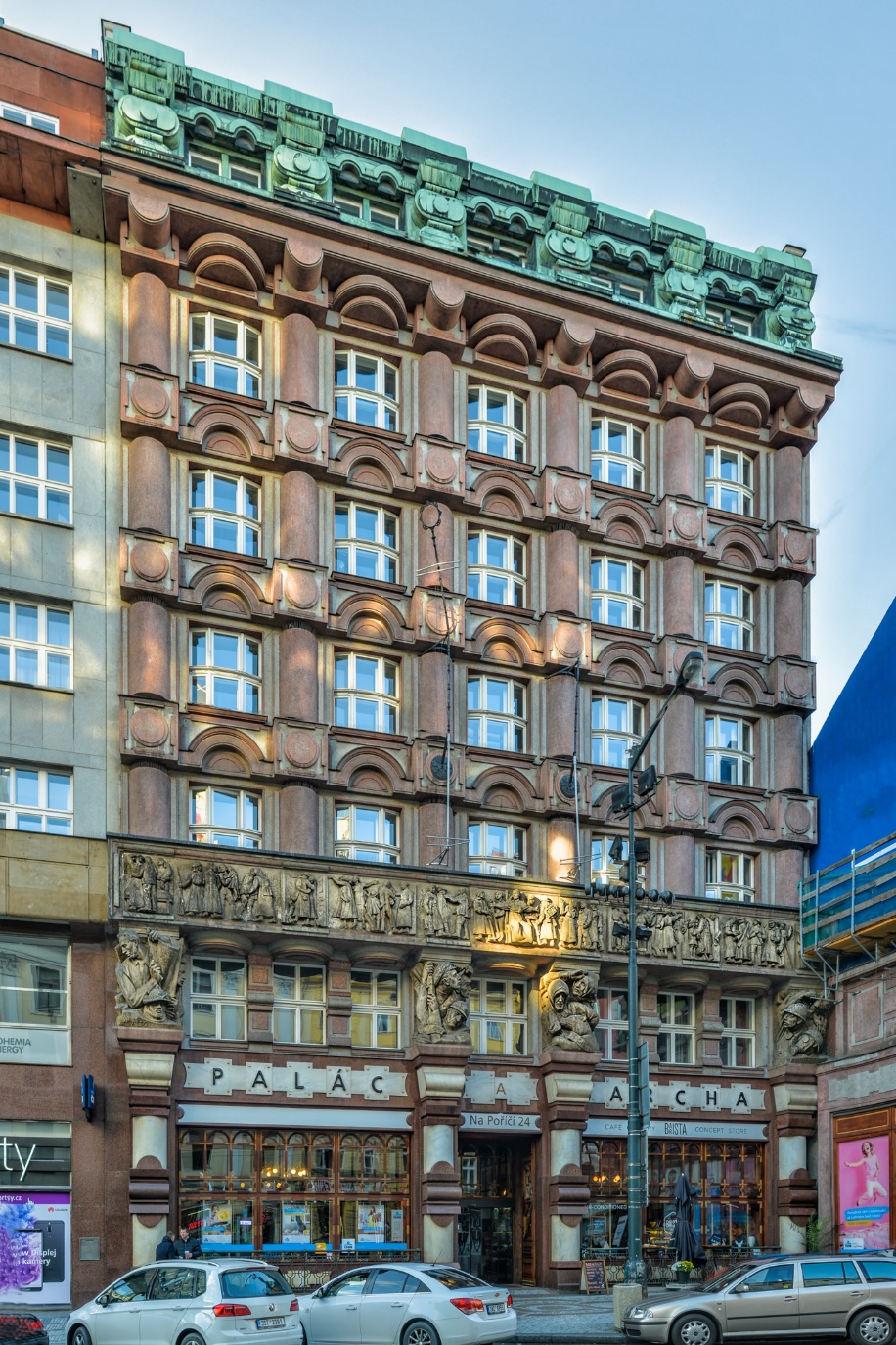
Functionalism, here, there and everywhere
In the 1920s one style gained great popularity. It had completely given up on ornateness and, as its name suggests, made structural form strictly subservient to function. Functionalism is discussed in more detail in a separate article. There are a number of excellent buildings showcasing this style in Prague, from private buildings (e.g. Villa Müller, the Winternitz Villa) to apartment buildings (e.g. "Molochov", the Glass Palace), public buildings (e.g. the Trade Fair Palace, the Prague Electrical Enterprises building) or industrial buildings (e.g. the Edison Transformer Station, Barrandov Film Studios), as well as church buildings (e.g. the Church of St Wenceslas in Vršovice).

Plečnik rides again…
Jože Plečnik, the long-serving professor of architecture in Prague who had already proved himself in the reconstruction of Prague Castle was to make his mark on the city's map one more time. He was entrusted with designing a church for the residents of Prague's Vinohrady district. The monumental Church of the Most Sacred Heart of Our Lord on Jiřího z Poděbrad square was inspired by Noah's Ark and regal symbolism (the façade evoking royal ermine, the dome at the top, the royal orb). The landmark feature of the construction is a broad tower, punctuated with the glass dial of the largest tower clock in the country, 7.5 metres across.
The simple, open-plan inner space of the church resembles an ancient sacred site or shrine. The walls of red brick contrast with the coffered ceiling and circular floor tiles. Light comes in through a strip of roof windows with modern stained glass windows by Karel Svolinský, that go all around the perimeter of the church. The dominant feature of the space is a large gilded statue of Jesus Christ above the altar and statues of the Czech Lands' six patrons along the sides.
The distinctive building is a beautiful example of architectural Modernism and rightly regarded as one of Prague's iconic sites.
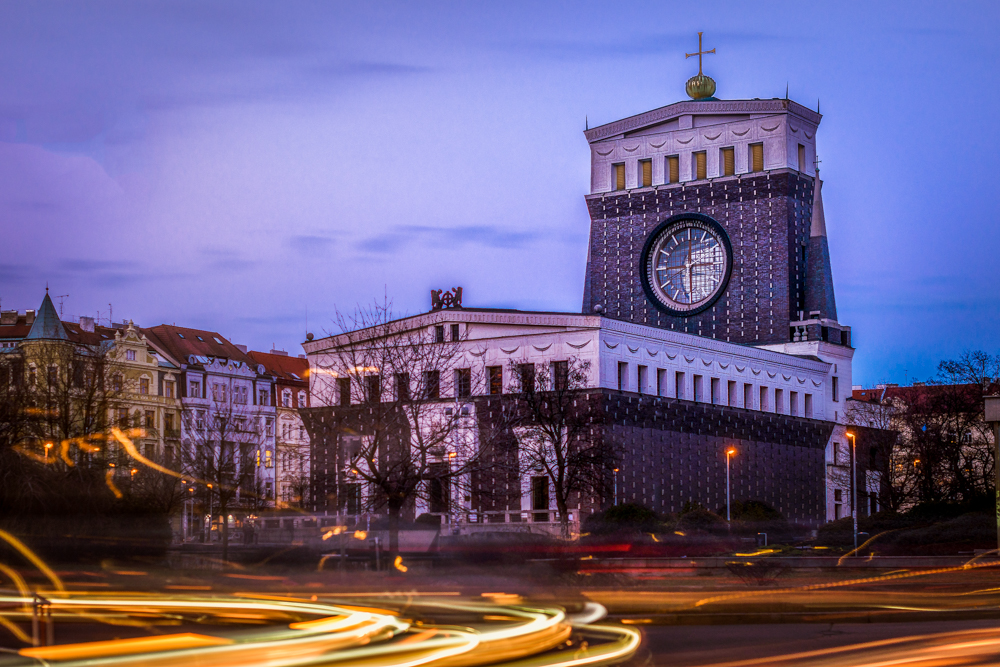
The Church of the Archangel Michael on Petřín Hill, a memento turned to ashes
Until recently, a latter 17th century timber church with shingled roof stood on the southern slope of Petřín Hill, in the Kinský Garden, as a typical example of the folk architecture of the Zakarpatska Oblast in today's Ukraine. It was brought to Prague in 1929 as a diplomatic memento, since this area, also known as Carpathian Ruthenia, was then a part of Czechoslovakia. The picturesque building was unique in that it was entirely wooden, not a single nail was used in its construction. The timbered building with three turrets was home to Orthodox Christianity and services were held regularly in Romanian and Czech. This unique Prague monument was lost in a devastating fire in 2020. A public collection for the restoration of the church is currently underway.

Prague Zoo, the whole world in one place
The intention to open a zoological garden in Prague is documented since the end of the 19th century, but all attempts to establish it were unsuccessful; until 1931 with Professor Jiří Janda, who became the first director of Prague Zoo. The zoo is second only to Prague Castle as the most visited tourist destination in the country and regularly ranks among the topmost listed best and most beautiful zoos in the world. Thanks to its exceptional size, varied terrain, 12 pavilions and more than 150 exhibits and other attractions, it offers day-long entertainment. Among the animals most popular with visitors are the local sea lions, a gorilla family and a herd of elephants, which continues to grow, to everyone's delight. The zoo has long been dedicated to the rescue of endangered species, both through its own animal husbandry and through fieldwork; in addition to the aforementioned lowland gorillas, there are the Przewalski horses, the gharial/gavial fish-eating crocodile from India and more.
Barrandov Studios, Czech Hollywood
The Barrandov Film Studios and the whole new district on the rocky promontory above the Vltava river also owe their existence to the aforementioned Havel family. Originally a garden-city residential district and a popular site for a Prague day out, the Barrandov Terrace Restaurant was the dream-come-true of Václav Mario Havel, father of the man who was to become President Václav Havel. His younger brother Miloš Havel, a successful businessman in the film industry, built the film studios here in record short time. In their heyday they were among the best in the world and could be boldly compared to the then Hollywood. The first clapperboard was heard here in 1933 and in the subsequent more than 80 years over 3000 sound films have been made. To this day, the studios are a well-regarded film centre popular with international productions. Films such as Mission: Impossible, Casino Royale, The Chronicles of Narnia and others were filmed here. There are a total of 13 film studios on the site, including one of the largest European soundproof studios, as well as extensive exteriors and one of the largest costume and prop collections in Europe. The Filmpoint exhibition space allows visitors to take a behind-the-scenes look at classic and recent TV and film projects.
National Memorial on Vítkov Hill
Let us conclude our excursion down memory lane to the First Republic by visiting the National Memorial on Vítkov Hill. The construction of this majestic Prague landmark took a lengthy 10 years, which greatly influenced its fate. The foundation stone of the building was laid in 1928, but the building was not handed over to the public until 1938, just before the Second World War. The monument was created in honour of Czechoslovak Legionnaires, but it soon became necessary to hide some of the collections from the occupying forces. The monument was sealed on the order the Reichsprotector until the end of the war. When the war ended, repairs began, but the original intention could not be fulfilled this time either, due to the Communist coup in 1948. Soviet-style communists wanted to turn the monument into a mausoleum for the first Communist president, Klement Gottwald. Fortunately, this did not happen, because the mummification of Gottwald's body by Soviet comrades was a failure, and in the end the body had to be cremated.
In 1950, a bronze statue of the Hussite leader Jan Žižka of Trocnov was put up in front of the monumental Functionalist building of the monument. Under his leadership, the Hussites had one of their many successful battles at Vítkov in 1420, trouncing the Crusader army. The statue is one of the largest equestrian statues in the world. Today, the Memorial houses the military-historical exhibits of the National Museum.
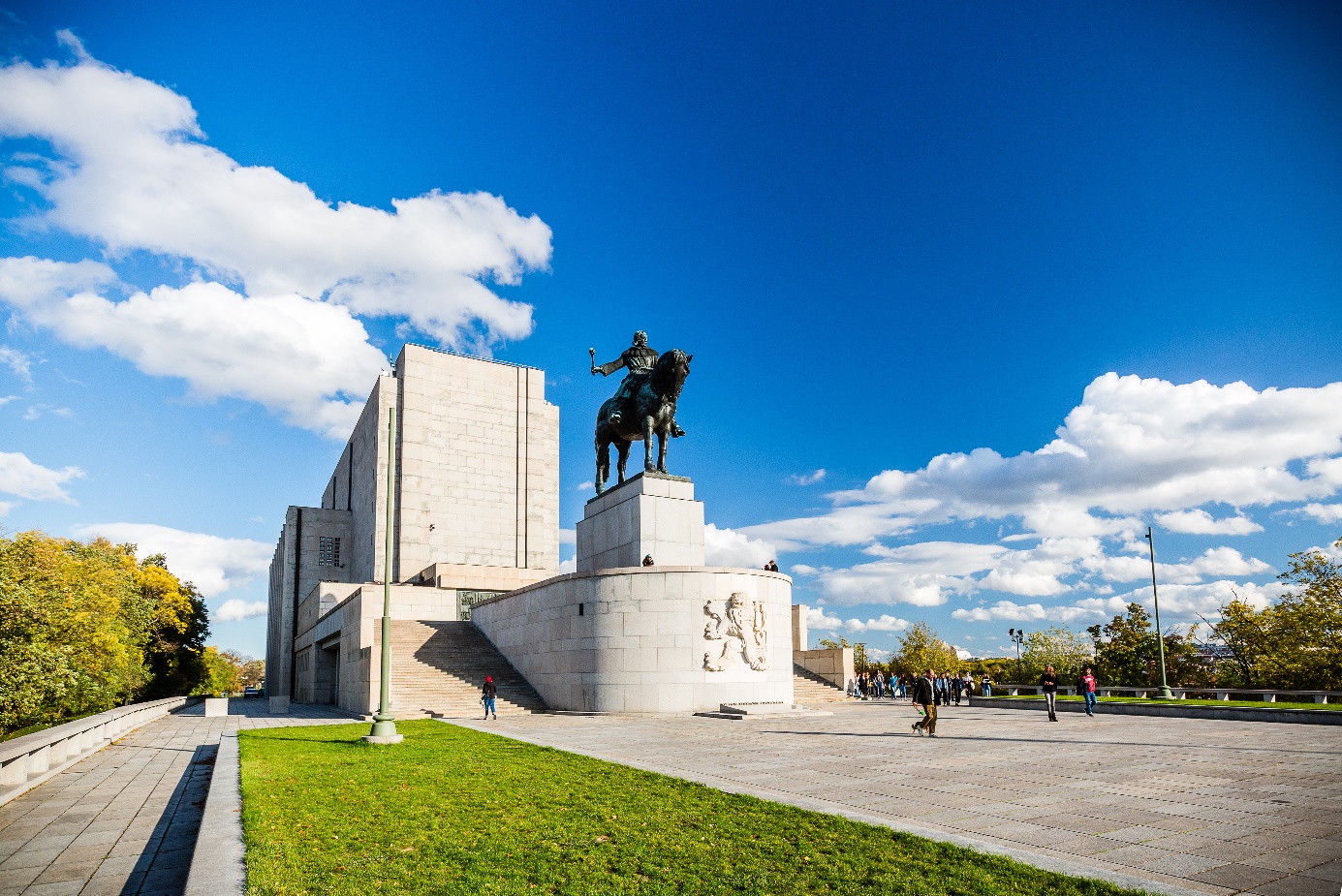
text: Prague City Tourism

